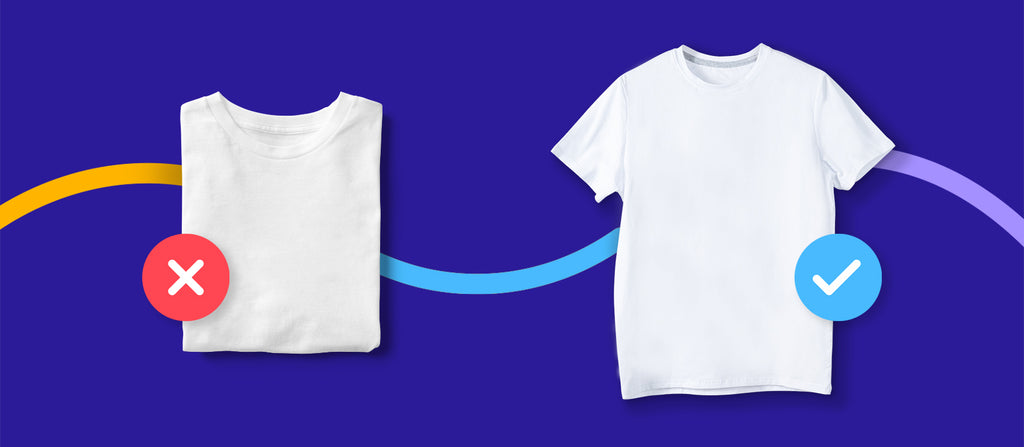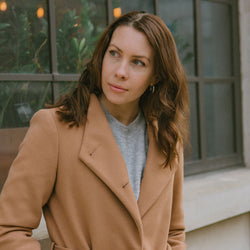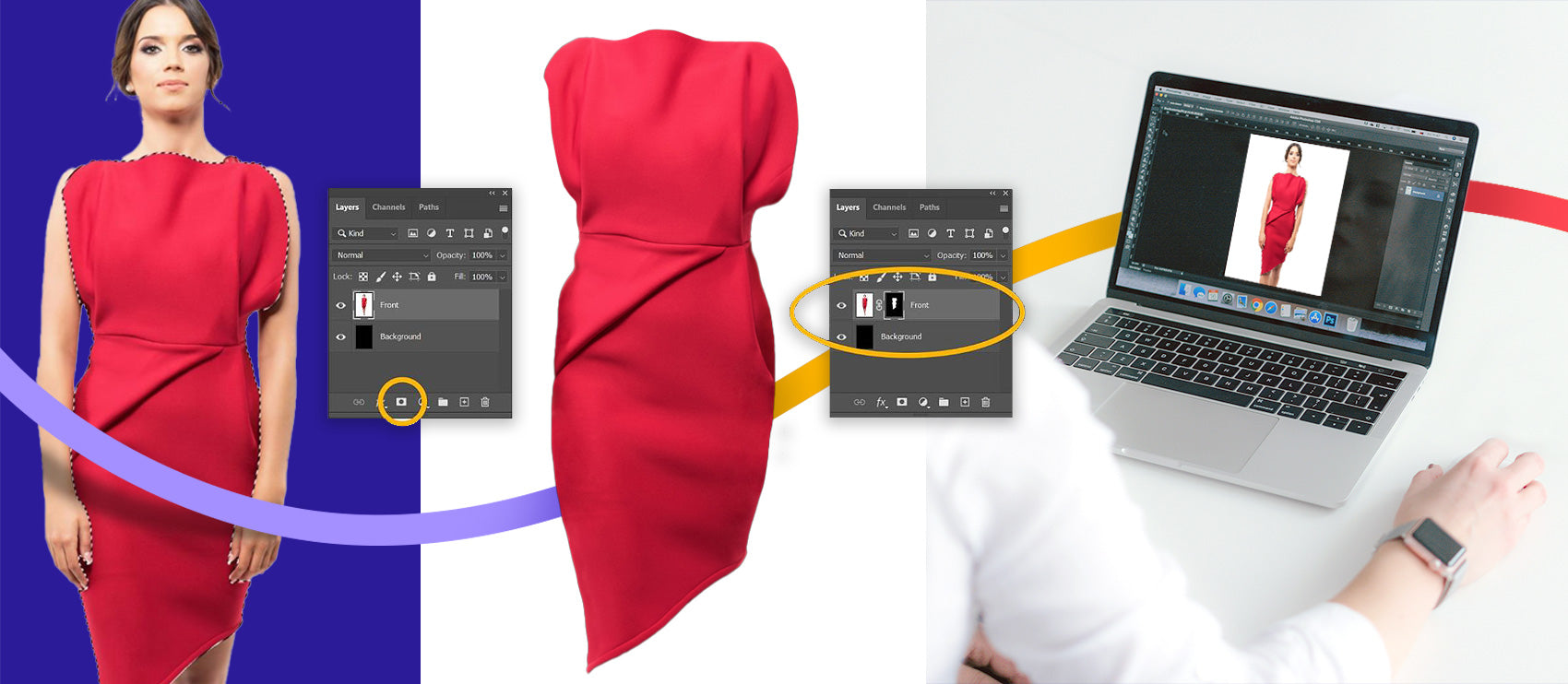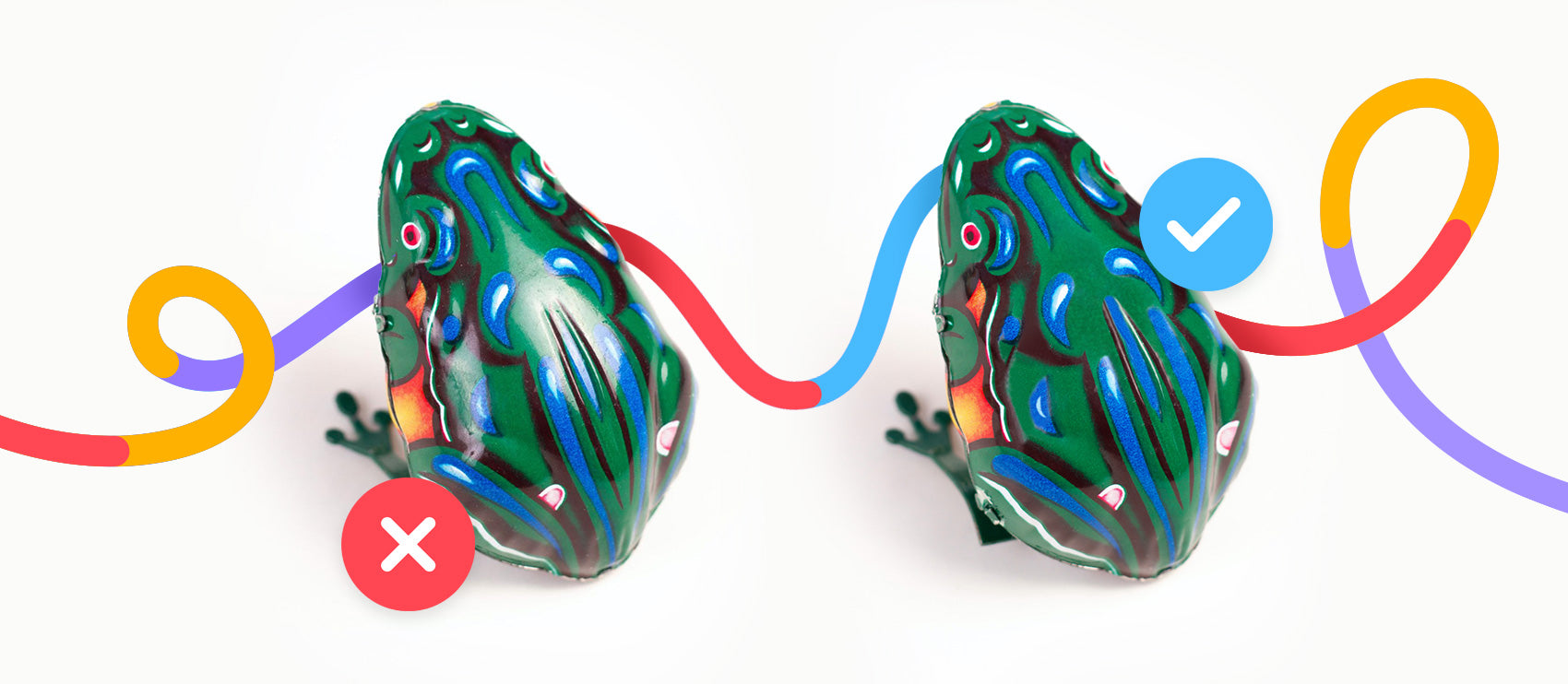Taking great pictures of clothing isn’t easy. Apparel on hangers looks lifeless, it can be difficult to style flat lay photos, and models are expensive. That’s where ghost mannequin product photos come into play. They create depth and visual appeal while eliminating the need to hire models.
Not every apparel shot will work to create ghost mannequin photos, but with our tips, you can learn how to create seamless ones that catch consumers’ eyes for all the right reasons.
What is ghost mannequin photography?
Ghost mannequin photography involves taking a photo of a garment on a mannequin or a person and then editing the photo to remove the mannequin. Doing so adds dimension to the product while creating the illusion that the garment is floating mid-air. It’s a popular technique used by ecommerce brands to showcase their products.
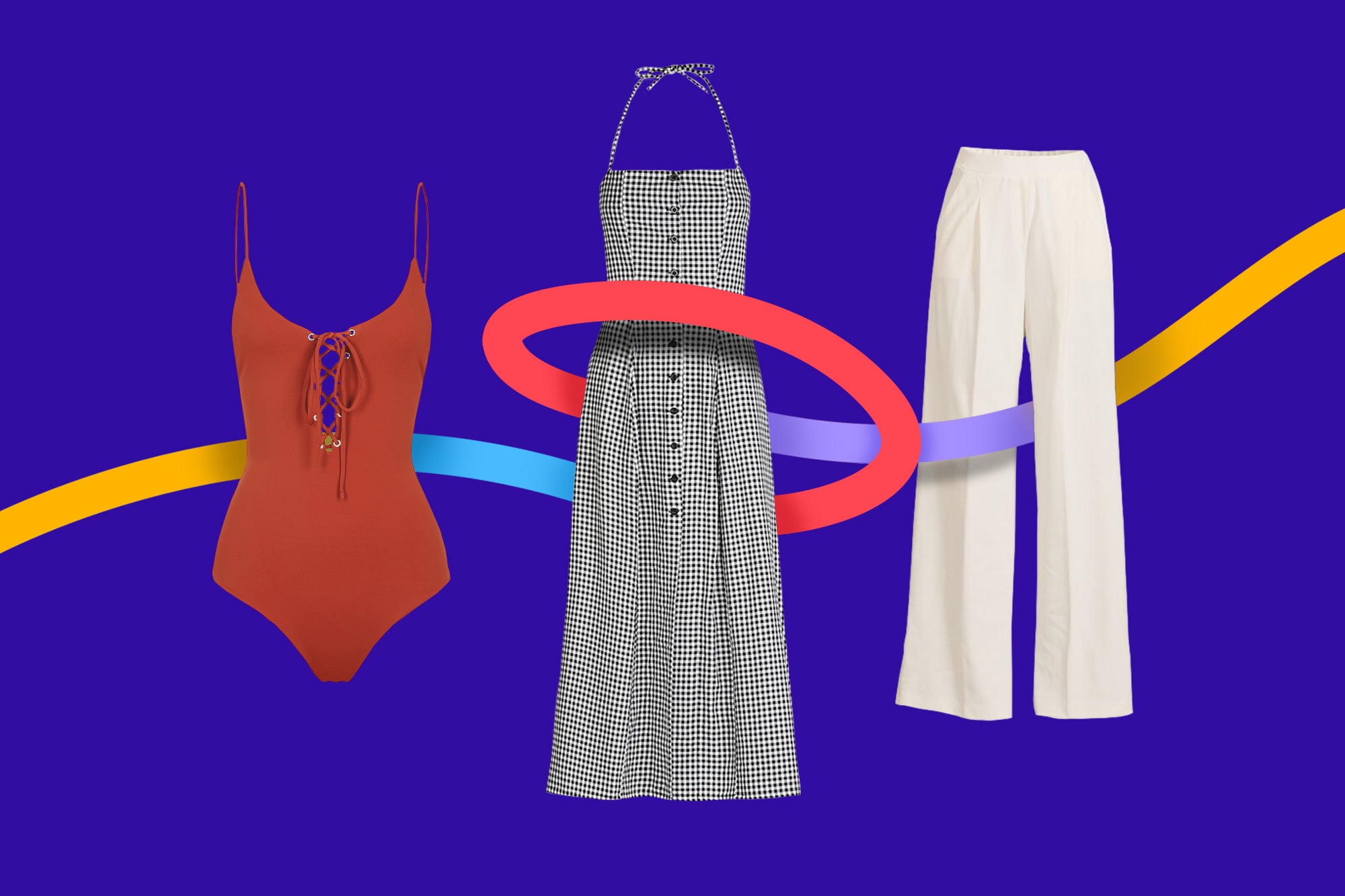
Ghost mannequin photography allows ecommerce brands to create compelling visuals that attract attention and convert customers. The cohesion that ghost mannequin photos bring to ecommerce store websites also makes it easy for consumers to browse products—all product listings have the same editing style and background, like you can see on outdoor retailer REI’s website:

Why use ghost mannequin product photos
According to one survey, as many as 90% of people say product images are either extremely or very important when shopping online for non-grocery products. You can use ghost mannequin photos of your apparel products to meet these expectations.

The following are just some of the advantages ghost mannequin photography can offer your business:
Add dimension and make products look realistic
It’s one thing to neatly arrange accessories or footwear for product shots in front of a white background, but it can be challenging to do the same with clothing. The garment’s style may not be suited for folding or laying it flat. The process is also time-consuming and doesn’t showcase the product at its best for shoppers to gauge how it looks when worn.
An invisible model, however, can demonstrate the fit of a garment—from lingerie and swimwear to outerwear.
Streamline your photoshoot
If you’ve ever hired professional models before, you know it can be expensive and challenging to coordinate. Ghost mannequin photography eliminates the need for hiring models and other creatives, like makeup artists, hair stylists, and assistants.
By skipping this part, you can focus on other aspects of your business or job and save time and money. Your shooting and editing workflow also becomes easier and faster with time.
Appeal to all customers
Without a human model in the photo, you don’t have to worry about isolating any of your customers by not representing them in your model choices for main product images. That’s not to say you shouldn’t consider inclusivity altogether. Nearly a quarter of consumers aged 18 to 25 want more diversity and inclusion in apparel and footwear brand advertising.
Eliminating models for product photos can allow you to focus on sourcing diverse, representative talent for marketing and lifestyle photos instead.
Showcase all angles and details
Shoppers want to inspect online purchases as they would in a physical store—they want to see the product from different angles. They also might want to see the inside of apparel, the fabric used, and small details, like lining, pockets, brand labels, and other features.
If you don’t use ghost mannequin photos for clothing, many of these details are omitted—for example, it’s virtually impossible to get a side view or interior shot without ghost mannequin images.
Environment-conscious women’s fashion retailer Girlfriend Collective uses a mix of ghost mannequin and live model photos for its products. On this bra listing, shoppers can see the inside lining of the racerback, something that would be impossible to demonstrate with a live model.

Put the focus on the product
Humans naturally look for faces in visuals, not inanimate objects. Knowing this can be great for creating effective banners, landing pages, and lifestyle photos—but not so much for white background ecommerce shots.
With more than 80% of fashion shoppers checking out on mobile, having listing photos that are easy to see and navigate on smaller screens is crucial for any apparel ecommerce business. By removing a person from your product photo, you also remove the distracting elements, like parts of a model’s face, hands, or feet. Now, the attention goes straight back to the product.
Bring consistency to online listings and shop website
With ghost mannequin photos on your website, shoppers know what to expect when they browse your products. Simple thumbnails with the same composition make it easy to compare products as consumers go from page to page.
Australia-based CLEONIE SWIMWEAR, for example, uses ghost mannequin shots for main images so you can see a uniform, consistent look when browsing shop pages. The white background also makes it easy to see the true color of each item.

How to execute ghost mannequin product photography
You can shoot and edit ghost mannequin photos in Adobe Photoshop yourself or outsource the job to a professional editing studio like Path.
For any ghost mannequin photograph to work, you’ll need two photos:
- A photo of the clothing on a mannequin or a live model
- A photo without showing any inside labels
The two types of photos will give you or the editor enough visual data to create a composite image with an invisible mannequin effect.
1. Put your garment “on” for the first photo
First, shoot your garment on a mannequin or a live model with their arms pointing down (for upper-body garments). Make sure you’ve steamed or ironed it first to get rid of as many wrinkles as possible.
Use a simple background, like a solid gray backdrop, and be sure to photograph the mannequin straight on, not at an angle. Doing so will avoid any distortion or skewing in the final image. Use a tripod to avoid any camera shake and keep the distance between the camera and the garment the same.
2. Take you garment “off” for the second photo
To photograph the inside of your garment, like the area of the clothing label, you can turn the garment inside out and put it back on the model or the mannequin. You can also use a whiteboard or foam core to clip your clothing item to it and stand it up in the same place you took the first shots.
Take a few photos using the same lighting, camera, and tripod setup for consistency.

3. Edit your ghost mannequin photos together
Next comes image editing to combine your photos and remove any imperfections—you can follow our step-by-step tutorial to learn how to edit your photos for a professional finish.
Get the most out of your ghost mannequin product photos
There’s more than one way to enhance your ghost mannequin photos—during the shoot and at the editing stage. We have also provided marketing tips to help you make the most of your photos and increase sales.
Retouch imperfections
Make sure the fabric of your clothing is taut and clean before the photoshoot. You should also look for wrinkles, seams, creases, stains, and loose threads. Have a steamer, safety pins, tape, and scissors on hand for any last-minute fixes on-set.
Checking that the clothing is polished will help you get a high-quality product look, but even at the best of times, you can miss an imperfection. Not all is lost because editing can usually fix those. It's a tedious process, but you can use photo retouching services to outsource and make room for more important business tasks.

Add shadow to give depth to products
If your ghost mannequin shots look flat, use drop shadows and reflective shadows to add depth. Doing so prevents your products from looking like cardboard cutouts and gives them dimension. Such a small change can instantly transform your photos for the better.

Apply color change for new variants
For any ecommerce business selling hundreds of items, it’s costly and time-consuming to shoot each new color variation of clothing. Instead, you can do a color change edit to the original ghost mannequin image for any new fabric colors or prints.

Add your branding or other elements for marketing images
Maybe you don't have product labels and tags at the time of the shoot. You can add tags to the interior in post-processing. Doing so is also helpful if your branding design changes but you don’t have the resources to reshoot your whole inventory. You can see how this photo from M.M.Lafleur showcases the brand tag.

Using the original ghost mannequin photo, you can also cut out the item and hang it on a rack or hanger with added design elements like graphics and text to highlight specific details. For example, the sustainable farm-to-closet clothing brand Pareto uses a photo of this crewneck sweater to show consumers the careful considerations behind the product’s design.

Create outfits
With ghost mannequin photos of your clothing, you can create image groups to increase sales without having to shoot each combination using live models.
- Show product variations in a single image: For easy product comparison, you can add a different color, pattern, or shape options in one photo. The responsibly-made underwear and loungewear label The MORI Club sells a bra duo pack. Using a single photo, consumers can choose which two styles to pick.

- Introduce the whole collection: Similar to product variations, you can combine all garments to show a selection of each new collection. The Los Angeles-based fashion label House of Aama uses this method to reveal newly-launched pieces on the brand’s Instagram page.

- Style outfits and sell them as a bundle: If you have ghost mannequin photos of your inventory, you can start curating outfits and selling them as product bundles. Getting rid of leftover stock, introducing buyers to new items, and offering seasonal promotions are just some benefits of bundling. Girlfriend Collective, for example, sells this bundle of workout outfit essentials and shows the higher price if shoppers buy all items individually.

360-spin images
Let customers see the product from every angle before they buy using 360-degree spin product photography. Augmented reality makes virtual shopping even more immersive by showing products in 3D. Shopify reports that some product pages using this technology increased conversion rates by up to 250%.
You don’t have to go straight into investing in an augmented reality app, though. A basic turntable and multiple shots of your product will give you an affordable entry into 360-spin photography.
Make online shopping a seamless experience
Shopping for clothes is a personal experience, but it can be challenging if consumers can’t get a good look at the products. Ghost mannequin photography is one feature you can add to your toolkit to help improve the user experience and boost conversions.
Consider outsourcing to a photo-editing studio like Path if the process is too time-consuming. Besides making your customers’ shopping journey easier, you’ll also save hours of your work day.
Let us look after your ghost mannequins, starting at just 99¢ per image
Learn more
